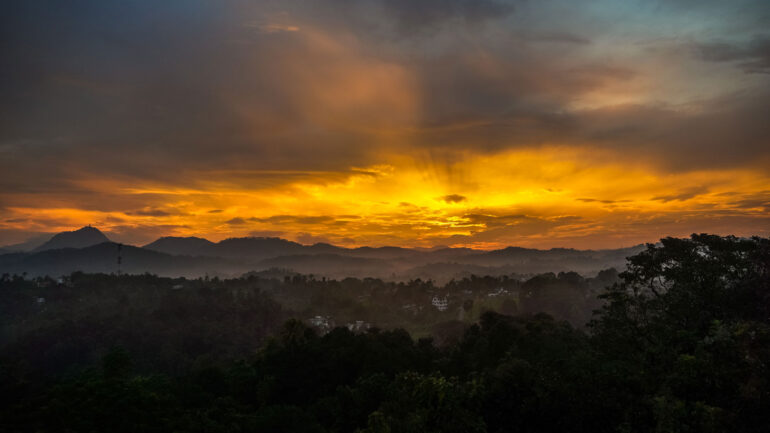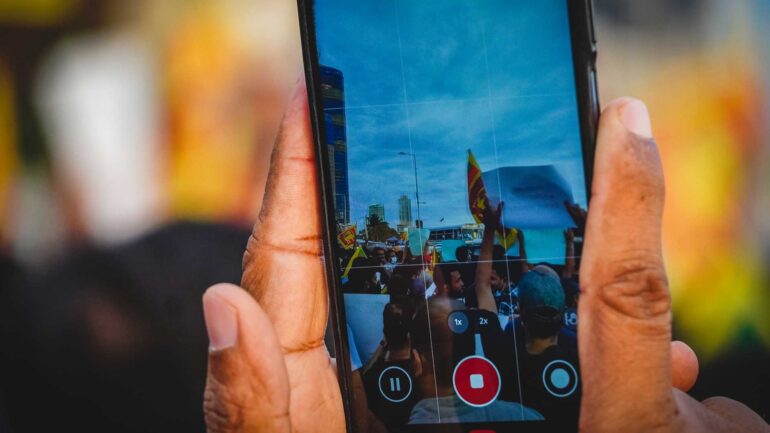Anura Kumara Dissanayake, leader of the leftist National People’s Power (NPP), rode a popular anti-establishment vote to power in last weekend’s Sri Lankan presidential election. The election, the first to be held at any level in the country since 2020, became an outlet for popular frustration with the political system and establishment political elite after the polycrises of the past few years. The misguided tax cuts under the 2019 Gotabaya Rajapaksa government, alongside the COVID-19 pandemic, had resulted in a debt repayment crisis and severe depletion of foreign reserves, culminating in the country’s bankruptcy for the first time in its history in 2022. Dissanayake’s left populist rhetoric promised to end political corruption and deliver economic relief, which appealed to voters. Though the 2024 elections recorded a voter turnout of 75 percent, compared to 83 percent in the previous election, likely driven by high numbers of emigration and increasing political disillusionment among voters.
The three-way race for Sri Lanka’s presidency ended with the ‘challenger’ Dissanayake leading the results, securing 42 percent of the cumulative vote, after the first round of counting. This is the first time in the country’s history when a candidate was appointed president without securing over 50 percent of the vote in the first round. As per election law, a second preference round of counting ensued, to determine the winner between Dissanayake and the runner-up Sajith Premadasa, who had secured 32 percent of the vote. Incumbent President Wickremesinghe obtained only 17 percent of the vote and was eliminated from the first round.
In trying to strike a balance between domestic aspirations and dire economic challenges, Dissanayake’s presidency, ushers in an era of hope but some uncertainty on the domestic and foreign policy fronts.
Rise of Alternative Politics
The socio-economic fallout of the 2022 economic crisis included the tripling of poverty levels and worsening child malnutrition, leading Sri Lanka to rank among the top five countries in the Asia Pacific with the highest wealth and income inequality. The mass street protests, popularly known as the Aragalaya, in response to the disruptions to electricity supply and import of essential goods such as fuel, gas, and medicines compelled the then-President Gotabaya Rajapaksa to resign and flee the country in July 2022. These protests demanded a system change and delegitimized the established political class, especially the Rajapaksa family, which had dominated Sri Lankan politics in the last two decades. The aggravated economic distress provided a fertile ground for mass dissent, which the leftist NPP captured in its social media, leading to Dissanayake’s meteoric rise in popularity.
While Sri Lanka entered a USD $2.9 billion IMF bailout program and debt restructuring process under President Ranil Wickremesinghe, who was elected by a parliamentary majority in July 2022, this primarily translated into a straightjacketing of public expenditure and a need for structural reforms. The growing economic hardships under austerity, coupled with a popular sense of the president being a protector of the now-delegitimized Rajapaksas, and widespread allegation of ongoing corruption, led to the government’s increasing unpopularity. The government was also criticized for introducing laws that contracted freedom of expression and democratic space, negating Wickremesinghe’s economic stability narrative and allowing Dissanayake to position himself to fill that leadership vacuum.
A Three-Cornered Race
In their policy outlook, all three front-running candidates converged on a liberal consensus and moved towards the center, promising to continue the IMF program and not resorting to Sinhala Buddhist nationalist rhetoric. However, beyond this policy convergence, some key distinctions among the candidates can help explain the electoral outcome.
The NPP’s Dissanayake, who won only around 3 percent of the vote in the last election, was able to successfully embody the popular anti-establishment anger following the economic crisis and tap into the undecided floating vote following the fall of the Sri Lanka Podujana Peramuna (or SLPP, the party led by the Rajapaksas). While conceding some ground to the liberal economic space, in order to appeal to the middle class and the business community, the NPP’s aligned its economic policy more closely to the ideological left, advocating domestic manufacturing and industrialization, especially in terms of reviving the agriculture sector, with shades of economic protectionism. Additionally, the NPP did not resort to strong Sinhala nationalist discourse, despite its past allegiance with these forces (as the Marxist-Leninist Janatha Vimukthi Peramuna or JVP, the main political party within the NPP) and receiving support from a predominantly Sinhala nationalist voter base in this election. These factors enabled Dissanayake to appeal strongly to the youth and women, as well as attract a substantial portion of the Muslim vote in the Central and Western provinces.
Meanwhile, Sajith Premadasa, the Leader of the Opposition and the Samagi Jana Balawegaya (SJB)’s presidential candidate, was unable to as successfully appeal to the anti-establishment sentiment, perhaps as he has been part of former governments and is the son of a former president. In addition, some crossovers occurred from the increasingly delegitimized government party (the SLPP) towards Premadasa as he formed a catch-all-party in the lead up to the election. On the economic front, Premadasa’s pro-poor rhetoric and identity, including the promises of subsidies and welfare, appear to have resonated strongly, especially among the rural areas. The party enjoyed a stronger support base across ethnicities, given its inclusive liberal democratic credentials, and managed to secure the lead in minority-dominant areas, including the North, East, and up-country.
Wickremesinghe arrived in third place after running as a candidate on an independent platform. There is a popular conception emerging that if Wickremesinghe and Premadasa had united, both originally coming from the UNP, an NPP victory could have been prevented. However, a closer examination of the electorates that swung to Wickremesinghe and Premadasa indicate a more complicated picture. Wickremesinghe’s technocratic expertise on the economy and minority-friendly politics in his nearly five-decade long political career cultivated a sizable following independent of any party allegiance. The patronage-savvy SLPP MPs who backed his campaign also funnelled some of their electorate towards him. These cumulatively explain the 17 percent vote he was able to secure. Ultimately, however, the government’s growing unpopularity and widespread disillusionment with establishment politics led to Dissanayake’s victory.
Dissanayake’s Domestic and Foreign Policy Challenges
Countries where economic crises of the scale Sri Lanka has faced since 2022 have seen quick circulation of governments that swing between center-right and center-left ideologies, before stabilizing. Apart from the serious challenges the new president faces in managing the precarious balance in the economy under an ongoing austerity program, the incoming leadership is likely to feel public pressure to manage expectations for economic relief and anti-corruption measures, especially the promise to repatriate assets stolen by corrupt politicians and officials.
On the foreign policy front, since the waning of the Non-Aligned Movement, Sri Lankan governments have attempted to maintain a balance among India, China, and the Western bloc, occasionally tilting towards one side. Since 2022, the Wickremesinghe government has attempted to balance its foreign policy among various partners, as its key bilateral creditors include all major geopolitical actors in the region. Sri Lanka’s post-war human rights record and reconciliation measures have posed another challenge in the country’s international diplomacy. During the Wickremesinghe presidency, these issues were somewhat muted as economic issues became a priority. But Dissanayake will have to chart his way through these complexities.
The NPP government is perceived to have a China bias, due to its ideological leanings and its historical and political affinities with China. Moreover, the JVP (the main party within the NPP) has had an antagonistic relationship with India in the past, opposing the Indian Peacekeeping Forces’ presence in the country during the late 80s and early 90s as well as the 1987 Indo-Lanka Peace Accord. But under the NPP, Dissanayake has assumed a more pragmatic stance towards India, as seen in the party’s India visit in 2024, and assurances that Sri Lanka will not be used to undermine the security interests of any regional actor. However, in the last week of the presidential race, Dissanayake promised to cancel the Adani Group’s wind power project in Sri Lanka due to sovereignty threats and lack of transparency. Reversing international development projects as part of election campaign promises is not unprecedented. In 2015, the Sirisena-Wickremesinghe government suspended China’s Colombo Port City land reclamation project, and in early 2020, Gotabaya Rajapaksa cancelled a light rail project that was funded by Japan. On both occasions, the same governments had to request these countries to renew these deals.
The Dissanayake presidency faces the challenge of balancing national economic realities with its party’s ideological baggage. The NPP’s perceived proximity to China will also make its relations with the United States cautious and uneasy, at least in the initial stages.
Way Forward
Even as the new government will have its hands full with stabilizing the economy and managing its international partners, internal social cohesion could pose a challenge. Despite this election being remarkable for its lack of divisive communal rhetoric, most of the electoral support for President Dissanayake came from the majority Sinhala Buddhist community. The fragmentation of the northern Tamil vote is significant—among Premadasa, a common candidate P. Ariyanethiran who obtained nearly 1.7 percent of the national vote, Wickremesinghe, and a sizeable section that boycotted the election as called for by the All Ceylon Tamil Congress. These developments signify the increasing inability of the Northern Tamil minority to substantially influence national politics, as they have in elections prior to 2019. This suggests a growing alienation of the community, which in turn could further polarize the electoral space going forward. Given the volatile nature of inter-ethnic relations in Sri Lanka, such polarization holds the risk of increasing instability.
Meanwhile, President Dissanayake is likely to set up a small four-member Cabinet of Ministers, with the three MPs the NPP currently has in parliament. After the president was sworn in, the NPP reiterated its promise to abolish the controversial executive presidency system that requires a two-thirds majority in parliament. The NPP needs to perform much better in a future parliamentary election to be able to secure even a simple majority required to form a government. In the absence of this, a cohabitation government with an SJB or Wickremesinghe-led alliance would mean increasing instability and uncertainty on the political and economic fronts.
Rajni Gamage and Harindra B Dassanayake
This article was originally published in South Asian Voices on 25 September 2024.
Image Copyright (c) 2024 President Media Division.



